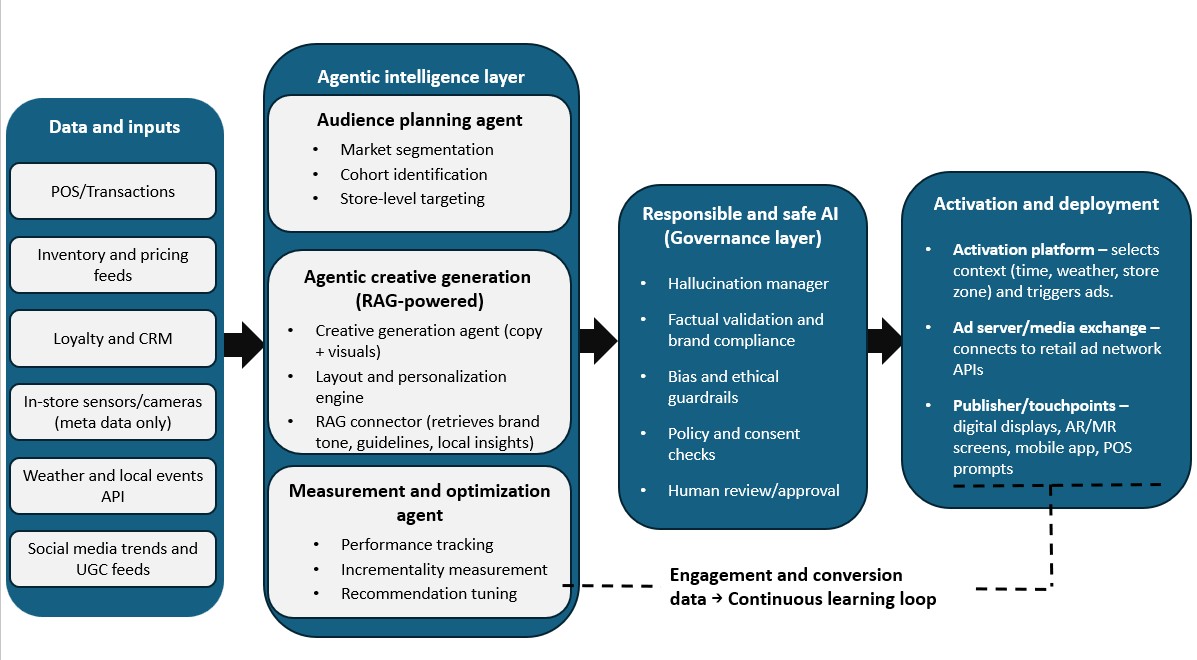Industry
HIGHLIGHTS
- Agentic AI redefines in-store monetisation by transforming physical stores from static environments into scalable, self-optimising media networks.
- It empowers brands to capture high-intent moments by orchestrating personalisation across key dimensions such as price, health, occasions, trends, and macro contexts such as sports and elections.
- This transformation shifts retailers from static, human judgement-driven promotions to data-driven, dynamic ads powered by a closed loop reporting engine, where every in-store interaction drives a measurable, profitable conversion.
On this page
The new retail imperative
Retailers today face intense competition from digital channels, where consumer expectations for personalised, dynamic experiences are shaped by ecommerce. Physical stores, often reliant on static displays and centrally driven promotions, are struggling to keep pace, losing both customer engagement and revenue opportunities. The challenge is clear: how can a physical environment be as adaptable and personalised as a shopper’s phone screen? The answer lies in shifting from simple, responsive technology to agentic artificial intelligence (AI) systems engineered to shift from reactive behaviour to anticipating plans and fine-tuning monetisation strategies with limited manual involvement. These agents continuously learn from context, generate hyper-localised creatives, and deliver them at the precise moment of shopper engagement, transforming stores into living, responsive media environments.
This paper provides a maturity-based transformation framework that outlines how retailers can evolve from static, manually managed environments to autonomous, self-optimising ecosystems driven by contextual intelligence.
Maturity levels in the transformation framework
Transforming physical stores into autonomous, revenue-generating media networks requires a phased evolution. Retailers can assess their current capabilities and plan the next phase of transformation.
- Stage 0: Static displays
Stores rely on posters and manual updates. Promotions are generic and have limited contextual targeting or personalisation. - Stage 1: Digitally enabled stores
Digital screens and displays enable real-time updates based on inventory or time of day and surface items with active promotions or those that need a boost in sales velocity. - Stage 2: Context-aware experiences
Agentic AI leverages contextual data such as weather, traffic, and local events to create highly personalised content. For example, it identifies customers who are most likely to purchase at a given moment and dynamically adjusts the creative and copy to appeal specially to them. - Stage 3: Intelligent and interactive engagement
Immersive technologies such as augmented and mixed-reality, and conversational assistants create guided, high-engagement experiences. For example, a sequence of contextualised ads drive brand awareness, improve consideration, encourage trials through coupons or promos, and trigger timely reminders to improve loyalty and repeat purchases. - Stage 4: Autonomous monetisation
Agentic AI autonomously generates creatives, deploys them, measures performance, and refines strategies—turning stores into continuously learning and revenue-generating ecosystems. Built on Stage 3 capabilities, AI agents automatically decide the right product to promote and the right brand objective to prioritise at the store level based on local context, effectively mimicking the judgement of an experienced store manager.
Agentic in-store monetisation architecture
Figure 1 illustrates how agentic AI unifies every element of the ecosystem into a single, self-learning system. Data from store operations, loyalty programmes, and external sources such as weather and social trends feed into the agentic intelligence layer, where autonomous agents plan audiences, generate creatives using retrieval-augmented generation (RAG), and measure results.
A governance layer ensures every creative passes through factual, ethical, and compliance checks before deployment across in-store screens and digital touchpoints. Each campaign’s performance data flows back into the system, enabling the agents to learn continuously and become more precise with every cycle.
This architecture forms the technical and operational backbone for the agentic store experience, which rests on four enabling pillars.
The four pillars of agentic store transformation
Delivering this dynamic experience requires a robust technical foundation built on four interconnected pillars:
- Digital interfaces and hyper-localisation: Screens and digital displays serve as the endpoints that leverage real-time local data such as inventory, weather, and foot traffic to deliver tailored and immediate product suggestions.
- Immersive AR, MR experiences: Virtual-reality (VR) and mixed-reality (MR) solutions allow shoppers to visualise or try products, reducing purchase hesitation. Integrated with agentic prompts, they guide the interaction toward a purchase.
- Contextual storytelling: Dynamic narratives automatically adjust to local environment and shopper intent, enriching the customer journey.
- Moderated user-generated content (UGC): Generative AI (GenAI) tools curate and filter peer reviews for tone and authenticity, while maintaining human oversight through manager dashboards, ensuring trust and brand integrity.
Overcoming implementation challenges
The journey toward agentic AI maturity requires overcoming several operational and organisational challenges:
- Data quality and fragmentation: The initial step requires unifying scattered and low-quality data across existing systems (such as point of sales (POS), inventory, and loyalty) to create a unified customer profile.
- System synchronisation: Retailers must establish real-time consistency between their online media networks and in-store placements to maintain cohesive messaging across touchpoints.
- ROI and incrementality mapping: A primary challenge is moving beyond correlation to establish a reliable incrementality measurement framework. This is crucial for accurately attributing revenue lift to agentic actions, ensuring a quantifiable return on investment (ROI).
- AI governance and ethics: As hyper-personalisation scales, retailers must proactively address the complexities of AI governance and ethics, including securing customer consent and managing the data responsibly.
- Talent and skillset development: Organisations must develop the talent and skillsets required to manage, monitor, and scale these sophisticated autonomous agents, shifting the internal team's focus from execution to strategic oversight.
Dimensions of contextual monetisation
Agentic AI continuously synthesises data from multiple dimensions to personalise the in-store message:
- Price value alignment: Identifies shoppers who purchased related products (for example, baby care products) and proactively triggers contextual offers on complementary items (for example, wipes), driving a larger basket size.
- Health and context: Integrates third-party application programming interfaces (APIs), like weather data, with purchase history to detect a shopper’s context. For instance, on a bright and sunny, high-UV day, a shopper at checkout may see a prompt in the in-store connected television (CTV) recommending a specific sunscreen brand, along with authentic reviews. This shifts the focus from simple product discovery to deeper engagement based on the context.
- Gifting and occasions: Autonomously drafts and rotates seasonal or festival-themed displays featuring augmented reality (AR)-enabled gift previews or user testimonials (for example, it may show a Massachusetts housewife decorating her suburban house with products bought from the retailer) that evoke emotion and boost conversion.
- Trending and news-based triggers: Monitors local social media and sales velocity to identify products that are trending in a specific region. It highlights these products with strong social proof, using scannable quick response (QR) codes for demos or personalised testimonials to drive faster trial-to-purchase conversion.
- Conversational guidance and post-purchase value: Enables customers to ask detailed questions or receive usage support (such as recipes or setup guides), seamlessly linking the in-store interaction to the product’s extended lifecycle and ensuring ongoing customer value.
Together, these dimensions enable agentic AI to deliver not just personalised messaging, but targeted influence—shaping shopper intent and behaviour in real time.
Influencing decisions in real time
A key capability of agentic AI is priming for precise targeting—using contextual cues to subtly shape shopper purchase decisions at the point of intent. By integrating live data such as weather, time, and social sentiment, the system tailors experience that guide shoppers toward relevant products. Key benefits include:
- Faster turnaround: Rapid creative generation and deployment
- Easy A/B testing: Quickly test and refine messages and offers
- Customer resonance: Identify features and benefits that truly resonate with customers
| Traditional displays | Agentic priming |
| Static: Same ad across stores and time periods | Dynamic: Content adapts based on time of day, weather, and foot traffic |
| Reactive: Rule-based; offers appear post-loyalty sign-in | Proactive: Offers a personalised bundle based on current basket and local trends at the time of checkout |
| Engagement focus: Measures sales without any detailed customer-level attribution | Monetisation focus: Measures immediate conversions and lift in average basket size at a customer level across each exposure |
Table 1: Traditional displays vs agentic priming
The next steps
The success of autonomous in-store monetisation lies in a robust data foundation and continuous agility. Retailers must:
- Consolidate first-party data (POS, loyalty, inventory) into high-fidelity customer cohorts
- Build modern data architecture, often leveraging real-time feature stores and vector databases, for training AI models
- Integrate AI systems with RAG systems that enable the AI systems to synthesise trusted, real-time context from the enterprise knowledge fabric
This foundation enables retailers to run rapid, agile experiments and conduct sophisticated incrementality mappings to identify the most profitable monetisation strategies for their physical environments.
Retailers who invest early in agentic AI foundations will turn their stores into an adaptive, self-optimising ecosystem that learns and monetises in real time. By uniting data, context, and intelligence, it transforms physical retail from static selling spaces into dynamic, experience engines.

